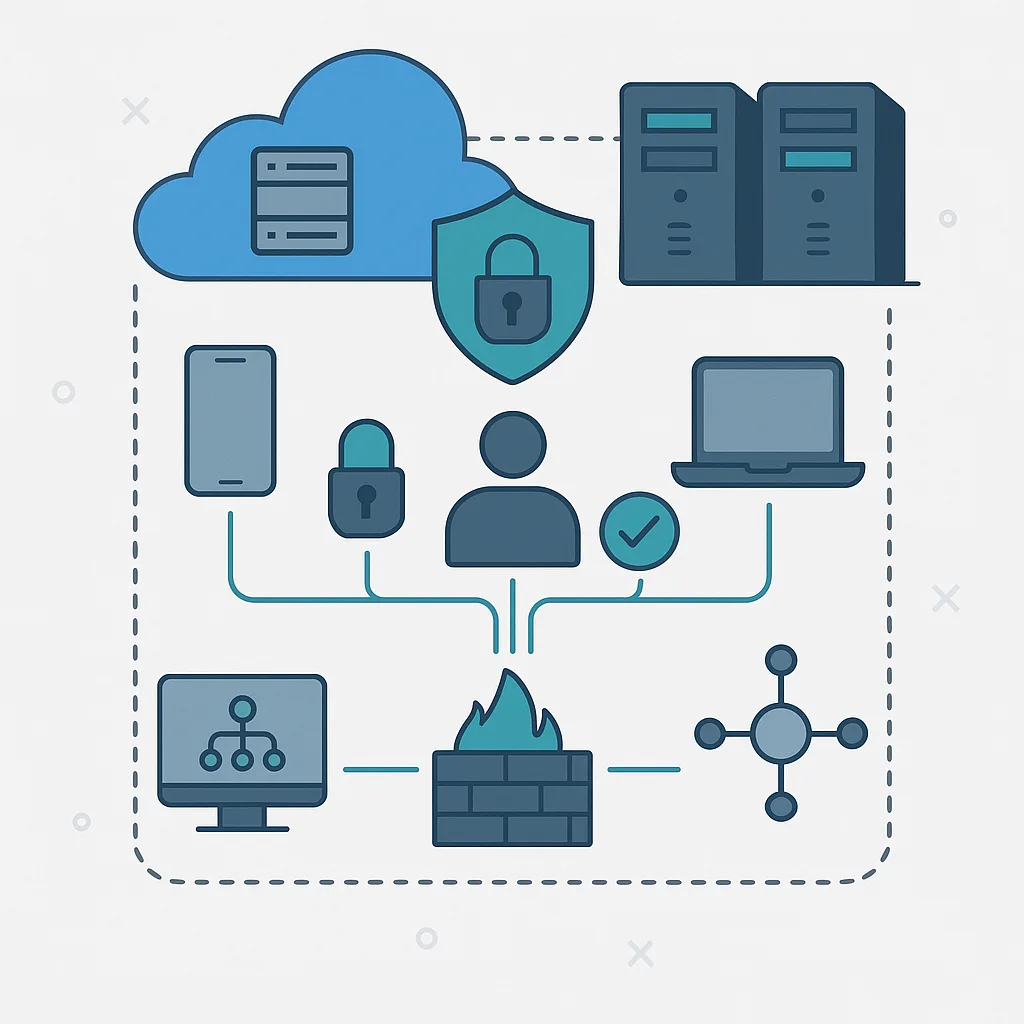Traditional network security relied on the assumption that everything inside the perimeter was trustworthy. But with hybrid environments combining cloud workloads, on-prem systems, remote users, and third-party access, that model is obsolete.
Zero Trust networking flips the script: it assumes that no user or system—inside or outside the network—is inherently trustworthy. Instead, every access request must be continuously authenticated, authorized, and monitored.
In this guide, we’ll walk you through how to build a Zero Trust architecture tailored for hybrid environments, including best practices for identity, access control, segmentation, and visibility.
What Is Zero Trust Networking?
Zero Trust is a security model that enforces:
- No implicit trust for users or devices
- Strict identity verification
- Granular access control
- Continuous monitoring
- Least privilege enforcement
It’s not a product, but a philosophy and framework—implemented using identity providers, access policies, network controls, and behavioral analytics.
Why Hybrid Environments Need Zero Trust
Hybrid infrastructures introduce new risks:
- Users connecting from personal devices
- Cloud-hosted applications outside traditional firewalls
- Legacy systems lacking modern authentication
- Overprivileged internal accounts
Zero Trust addresses these challenges by treating every access attempt as potentially hostile, even inside your own network.
Core Principles of Zero Trust
- Verify Explicitly
Always authenticate and authorize using all available context: user identity, device health, location, and behavior. - Use Least Privilege Access
Grant only the minimal level of access needed for each task. - Assume Breach
Design your network and access policies under the assumption that any user or system could be compromised.
Step-by-Step: Implementing Zero Trust in a Hybrid Environment
Step 1: Map Your Assets and Users
Inventory:
- All users (employees, vendors, remote staff)
- All devices (laptops, phones, servers)
- All workloads (on-prem apps, cloud services, SaaS)
- Network boundaries and segments
Use CMDBs, endpoint management tools, and cloud inventory services to maintain visibility.
Step 2: Establish Strong Identity and Access Management (IAM)
Key Actions:
- Integrate cloud and on-prem identities (e.g., Active Directory + Azure AD)
- Enforce Multi-Factor Authentication (MFA) everywhere
- Enable Single Sign-On (SSO) for seamless, secure access
- Apply Conditional Access Policies (e.g., block access from unknown devices or countries)
Use identity as the primary perimeter.
Step 3: Segment Networks and Workloads
- Use VLANs for broad segmentation
- Implement microsegmentation using firewalls or host-based policies to isolate apps
- Use cloud security groups to enforce workload separation (e.g., AWS SGs, Azure NSGs)
- Restrict east-west traffic between segments
This limits lateral movement if an attacker gets in.
Step 4: Implement Device Trust
- Require device compliance checks before granting access
- Integrate with Endpoint Detection and Response (EDR) tools
- Use certificates or hardware-based authentication (e.g., TPMs)
- Block jailbroken or outdated devices
Device health is a key pillar of Zero Trust.
Step 5: Secure Application Access with Proxies or Gateways
- Deploy reverse proxies or identity-aware proxies to front-end internal apps
- Use Zero Trust Network Access (ZTNA) instead of traditional VPNs
- Apply per-app access policies (not just network-level)
- Monitor app-layer behavior for anomalies
This allows you to secure legacy apps without rewriting them.
Step 6: Monitor, Log, and Analyze
- Centralize logs from identity providers, firewalls, endpoints, and applications
- Set alerts for suspicious patterns (e.g., impossible travel, privilege escalation)
- Use User and Entity Behavior Analytics (UEBA)
- Automate incident response with SOAR tools if possible
Visibility is critical to enforcing and improving your Zero Trust posture.
Step 7: Apply Least Privilege and Just-In-Time Access
- Regularly audit roles and group memberships
- Use Just-In-Time (JIT) access for admins and critical apps
- Rotate service account credentials regularly
- Eliminate unused accounts and stale permissions
Minimize the damage a compromised identity can do.
Zero Trust in Hybrid Scenarios
On-Prem Servers
- Use network segmentation + local firewalls
- Protect management interfaces with MFA
- Monitor logins and endpoint health
Cloud Workloads
- Apply IAM roles, policies, and tags
- Enable service-to-service authentication
- Use cloud-native firewalls and runtime protections
SaaS Applications
- Integrate with your IdP
- Enable SSO and MFA
- Restrict access by group, location, or device
Remote Workers
- Enforce device compliance
- Use ZTNA or SASE platforms
- Log all activity and enable continuous verification
Common Mistakes to Avoid
- Relying only on firewalls and VPNs
- Granting persistent, broad access
- Skipping visibility for internal traffic
- Not integrating cloud and on-prem identities
- Ignoring legacy systems in the Zero Trust design
Conclusion
Implementing Zero Trust in a hybrid environment isn’t a one-time project—it’s a continuous strategy. By verifying identities, segmenting access, monitoring activity, and enforcing least privilege, you build a network that is resilient, adaptive, and secure by design.
Zero Trust doesn’t mean zero usability—done right, it provides better security with minimal disruption, making it the ideal framework for the modern hybrid enterprise.


